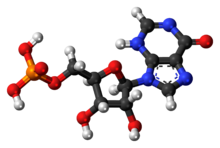Inosinic acid
 |
|
 |
|
| Names | |
|---|---|
|
IUPAC name
5'-Inosinic acid
|
|
| Other names
IMP,
Hypoxanthine ribotide |
|
| Identifiers | |
|
131-99-7 |
|
| 3D model (Jmol) | Interactive image |
| ChEBI |
CHEBI:17202 |
| ChEMBL |
ChEMBL1233478 |
| ChemSpider |
8264 |
| ECHA InfoCard | 100.004.588 |
| E number | E630 (flavour enhancer) |
| 5124 | |
| MeSH | Inosine+monophosphate |
| PubChem | 8582 |
|
|
|
|
| Properties | |
| C10H13N4O8P | |
| Molar mass | 348.21 g·mol−1 |
|
Except where otherwise noted, data are given for materials in their standard state (at 25 °C [77 °F], 100 kPa).
|
|
|
|
|
| Infobox references | |
Inosinic acid or inosine monophosphate (IMP) is a nucleoside monophosphate. Widely used as a flavor enhancer, it is typically obtained from chicken byproducts or other meat industry waste. Inosinic acid is important in metabolism. It is the ribonucleotide of hypoxanthine and the first nucleotide formed during the synthesis of purine. It is formed by the deamination of adenosine monophosphate, and is hydrolysed from inosine. IMP is an intermediate ribonucleoside monophosphate in purine metabolism. The enzyme deoxyribonucleoside triphosphate pyrophosphohydrolase, encoded by YJR069C in Saccharomyces cerevisiae and containing (d)ITPase and (d)XTPase activities, hydrolyzes inosine triphosphate (ITP) releasing pyrophosphate and IMP.
Important derivatives of inosinic acid include purine nucleotides found in nucleic acids and adenosine triphosphate, which is used to store chemical energy in muscle and other tissues.
In the food industry, inosinic acid and its salts such as disodium inosinate are used as flavor enhancers.
The inosinate synthesis is complex, beginning with a 5-phosphoribosyl-1-pyrophosphate (PRPP). In the first step, an amino group given by glutamine is attached at carbon 1 of PRPP. The resulting molecule is 5-phosphoribosylamine, which is highly unstable, with a half-life of 30 seconds at physiologic pH. 5-Phosphoribosylamine gains an amino acid (glycine), becoming glycinamide ribonucleotide (GAR). Then, N10-formyltetrahydrofolate (tetrahydrofolate) transfers a formyl group to glycinamide ribonucleotide to form formyl glycinamide ribonucleotide (FGAR).
...
Wikipedia
